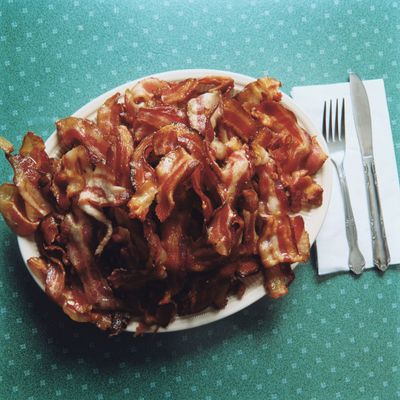
Fall may be billed as pumpkin season, but, really, it’s bacon season. This is the time of year when you embrace your inner lumberjack by wearing flannel and letting your body hair return to its natural state. Savory, cured meats are an essential part of this pre-hibernation cycle.
But remember when the World Health Organization said bacon causes cancer? Or when salad chain Sweetgreen banned it? Those were dark times. But aside from hipster salad purveyors, no one has said bacon is totally off-limits. So how much can you get away with eating before you turn into a toxin-filled solid, encased in said flannel?
Technically, one serving of bacon is 15 grams, or a little more than one cooked slice, says Caroline West Passerrello, a spokesperson for the Academy of Nutrition and Dietetics. It all depends on how thick and how long the slices are, but as with avocados and many other delicious foods, people usually eat a lot more than the serving size — restaurants often shove six or seven slices of bacon next to your omelette. But, hey, protein, right? Not exactly.
“Even though it comes from an animal and it has some protein, it’s really a fat,” Passerrello says. And bacon is considered a regular fat, not a healthy fat like avocado. It does contain some monounsaturated fat, but that good stuff comes alongside higher-than-desired amounts of saturated fat, cholesterol, and sodium. So, she says, “in the general, healthy public — folks who don’t have heart disease and are fairly active — it’s an ‘okay sometimes’ food.”
Which leads us to those times when there’s a pile of bacon on your plate at brunch. How much of it you eat depends on what the rest of your diet looks like, Passerrello says, so generally clean eaters get more leeway here. “If you have six slices [in a week], that very well may fit with what you eat. If you’re being aware of the sodium and the cholesterol, and it’s one of the few processed meats that you eat, I may suggest eating one or two slices less, but I don’t know what your calorie needs are!” she says.
You could get protein from another food that’s lower in total fat and cholesterol, but she points out that the satisfaction and pleasure derived from bacon are worth taking into account. “You might not get that [feeling] from turkey bacon or Canadian bacon.” Definitely not.
On the other hand, if you already eat multiple servings of processed meat each week (like ham, sausage, pepperoni, salami, and hot dogs), unfortunately, that means less bacon for you. While there are valid criticisms of the WHO’s classification of cured meats as carcinogenic, it’s best to eat as little processed flesh as possible. And work out. And sit less.
“The general idea is, let’s not get so hung up on one food, like bacon,” Passerrello says. “If you like it, eat it. It’s what else you do — what’s your lifestyle, what’s the meal, what does the week look like?”




